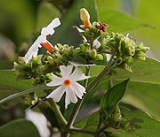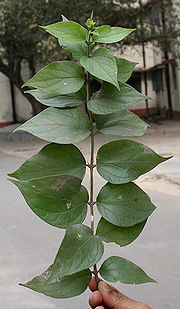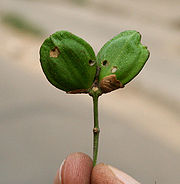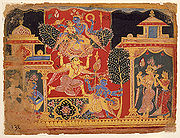
Night-flowering Jasmine
Encyclopedia


Nyctanthes
Nyctanthes is a genus of flowering plants in the family Oleaceae, native to southeastern Asia. It is currently accepted as containing two species; other species previously included in this genus have been transferred to other genera, most of them to Jasminum.They are shrubs or small trees growing...
, native to southern Asia
Asia
Asia is the world's largest and most populous continent, located primarily in the eastern and northern hemispheres. It covers 8.7% of the Earth's total surface area and with approximately 3.879 billion people, it hosts 60% of the world's current human population...
, from northern Pakistan
Pakistan
Pakistan , officially the Islamic Republic of Pakistan is a sovereign state in South Asia. It has a coastline along the Arabian Sea and the Gulf of Oman in the south and is bordered by Afghanistan and Iran in the west, India in the east and China in the far northeast. In the north, Tajikistan...
and Nepal
Nepal
Nepal , officially the Federal Democratic Republic of Nepal, is a landlocked sovereign state located in South Asia. It is located in the Himalayas and bordered to the north by the People's Republic of China, and to the south, east, and west by the Republic of India...
south through northern India
India
India , officially the Republic of India , is a country in South Asia. It is the seventh-largest country by geographical area, the second-most populous country with over 1.2 billion people, and the most populous democracy in the world...
and southeast to Thailand
Thailand
Thailand , officially the Kingdom of Thailand , formerly known as Siam , is a country located at the centre of the Indochina peninsula and Southeast Asia. It is bordered to the north by Burma and Laos, to the east by Laos and Cambodia, to the south by the Gulf of Thailand and Malaysia, and to the...
.
It is a shrub
Shrub
A shrub or bush is distinguished from a tree by its multiple stems and shorter height, usually under 5–6 m tall. A large number of plants may become either shrubs or trees, depending on the growing conditions they experience...
or a small tree
Tree
A tree is a perennial woody plant. It is most often defined as a woody plant that has many secondary branches supported clear of the ground on a single main stem or trunk with clear apical dominance. A minimum height specification at maturity is cited by some authors, varying from 3 m to...
growing to 10 m tall, with flaky grey bark. The leaves
Leaf
A leaf is an organ of a vascular plant, as defined in botanical terms, and in particular in plant morphology. Foliage is a mass noun that refers to leaves as a feature of plants....
are opposite, simple, 6–12 cm long and 2–6.5 cm broad, with an entire margin. The flower
Flower
A flower, sometimes known as a bloom or blossom, is the reproductive structure found in flowering plants . The biological function of a flower is to effect reproduction, usually by providing a mechanism for the union of sperm with eggs...
s are fragrant, with a five- to eight-lobed white corolla with an orange-red centre; they are produced in clusters of two to seven together, with individual flowers opening at dusk and finishing at dawn. The fruit
Fruit
In broad terms, a fruit is a structure of a plant that contains its seeds.The term has different meanings dependent on context. In non-technical usage, such as food preparation, fruit normally means the fleshy seed-associated structures of certain plants that are sweet and edible in the raw state,...
is a flat brown heart-shaped to round capsule
Capsule (fruit)
In botany a capsule is a type of simple, dry fruit produced by many species of flowering plants. A capsule is a structure composed of two or more carpels that in most cases is dehiscent, i.e. at maturity, it splits apart to release the seeds within. A few capsules are indehiscent, for example...
2 cm diameter, with two sections each containing a single seed
Seed
A seed is a small embryonic plant enclosed in a covering called the seed coat, usually with some stored food. It is the product of the ripened ovule of gymnosperm and angiosperm plants which occurs after fertilization and some growth within the mother plant...
.
Names and symbolism
Nyctanthes arbor-tristis (sometimes incorrectly cited as Nyctanthes arbortristis or Nyctanthes arbor tristis) is commonly known asSewali pronounced as Hkhewali in Assamese
Assamese language
Assamese is the easternmost Indo-Aryan language. It is used mainly in the state of Assam in North-East India. It is also the official language of Assam. It is also spoken in parts of Arunachal Pradesh and other northeast Indian states. Nagamese, an Assamese-based Creole language is widely used in...
'Shephali (শেফালী) or Shiuli (শিউলি) in Bengali
Bengali language
Bengali or Bangla is an eastern Indo-Aryan language. It is native to the region of eastern South Asia known as Bengal, which comprises present day Bangladesh, the Indian state of West Bengal, and parts of the Indian states of Tripura and Assam. It is written with the Bengali script...
. Official State flower of West Bengal
West Bengal
West Bengal is a state in the eastern region of India and is the nation's fourth-most populous. It is also the seventh-most populous sub-national entity in the world, with over 91 million inhabitants. A major agricultural producer, West Bengal is the sixth-largest contributor to India's GDP...
.
- Night-flowering Jasmine
- Coral Jasmine
- Parijat (also spelled Paarijat or Paarijaata)
- Harsingar
- Shephalika,Parijatha, Parijataka, Ragapushpi, Kharapatraka, Prajakta
Nalakumkumaka, Harshingarapushpak, Suklangi, Rajanihasa, Malika,
Aparajitha, Vijaya, Nisahasa, Praharshini, Pravalanalika,
Vathari, bhoothakeshi, Seetamanjari, Subaha, Nishipushpika (in Sanskrit)
- Paarijaat(ಪಾರಿಜಾತ) or Goli (ಗೋಳಿ) in KannadaKannada languageKannada or , is a language spoken in India predominantly in the state of Karnataka. Kannada, whose native speakers are called Kannadigas and number roughly 50 million, is one of the 30 most spoken languages in the world...
- Pavazha malli in TamilTamil languageTamil is a Dravidian language spoken predominantly by Tamil people of the Indian subcontinent. It has official status in the Indian state of Tamil Nadu and in the Indian union territory of Pondicherry. Tamil is also an official language of Sri Lanka and Singapore...
(Also spelled pavaza malli or pavala malli) - Prajakta or Prajakt in Sanskrit
- Shephali (ଶେଫାଳି) or Ganga Shiuli (ଗଙ୍ଗ ଶିଉଳି) in OriyaOriya languageOriya , officially Odia from November, 2011, is an Indian language, belonging to the Indo-Aryan branch of the Indo-European language family. It is mainly spoken in the Indian states of Orissa and West Bengal...
The tree is sometimes called the "tree of sorrow", because the flowers lose their brightness during daytime; the scientific name arbor-tristis also means "sad tree". The flowers can be used as a source of yellow dye
Dye
A dye is a colored substance that has an affinity to the substrate to which it is being applied. The dye is generally applied in an aqueous solution, and requires a mordant to improve the fastness of the dye on the fiber....
for clothing. The flower is the official flower of the state of West Bengal
West Bengal
West Bengal is a state in the eastern region of India and is the nation's fourth-most populous. It is also the seventh-most populous sub-national entity in the world, with over 91 million inhabitants. A major agricultural producer, West Bengal is the sixth-largest contributor to India's GDP...
, India, and for Kanchanaburi Province
Kanchanaburi Province
- History :Archaeology found in Kanchanaburi dates back to the 4th century which proves of trade with surrounding countries even in that time. Very little is also historically known about the actual Khmer influence in Kanchanaburi but there is evidence of their occupation with Prasat Muang Singh –...
, Thailand.
Medicinal use of Parijata
The natives of Chhattisgarh are aware of medicinal uses of all parts of Parijat. They use the seeds in treatment of Bavasir (Piles). Daily one seed with water is recommended as treatment. This treatment is continued up to complete cure. The seeds are crushed and aqueous paste is prepared. The patients suffering from piles are advised by the natives to apply fresh paste externally on piles, along with the internal use of seeds. This treatment is simple and very effective. In treatment of gout, the natives use the decoction of Parijat flowers. This decoction is given up to one week during the time of attack. As treatment, it is given up to one month in a year. The natives of Sarguja region use the leaves of Parijat in many ways. In treatment of dry cough, the leaf juice with Shahad (Honey) is given internally. The aqueous paste of leaves is used externally in treatment of skin related troubles specifically in treatment of ring worm. The natives of Bastar region, prepare a special herbal oil by boiling fresh leaves in Sarson (Mustard) oil and use it externally in treatment of same troubles. The natives of Chhattisgarh Plains, use the leaf juice with Namak (Common salt) in treatment of intestinal worms. According to them, seven regular doses (once in a day) can flush out all the worms effectively. The young leaves of Parijat are used as female tonic. The patients having gynaecological troubles are advised to take three fresh leaves of Parijat with 5 Black Pipper (Kali Mirch). This combination is recommended up to three days in a month. According to the natives using this combination, this is a boon for the patients at initial stages. In case of complications, the natives consult the traditional healers. The natives of Bagbahera region, use the decoction of Parijat seeds as hair tonic and wash the hairs daily in order to get rid from dandruff, and lice. The natives of Durg region specifically from Patan region, informed me that leaf juice is a safe purgative for infants. They also use it in combination with other herbs in treatment of chronic fevers.This is positive sign that the natives having rich traditional medicinal knowledge about Parijat are still using this herb as medicine and planting this herb in their home gardens. By this act, they are transferring and making aware the upcoming generation about the valuable medicinal properties and uses of Parijat.
Mythology

Bhagavata purana
The Bhāgavata Purāṇa is one of the "Maha" Puranic texts of Hindu literature, with its primary focus on bhakti to the incarnations of Vishnu, particularly Krishna...
, the Mahabharata
Mahabharata
The Mahabharata is one of the two major Sanskrit epics of ancient India and Nepal, the other being the Ramayana. The epic is part of itihasa....
and the Vishnu Purana
Vishnu Purana
The Vishnu Purana is a religious Hindu text and one of the eighteen Mahapuranas. It is considered one of the most important Puranas and has been given the name Puranaratna...
, Parijat appeared as the result of the Samudra manthan
Samudra manthan
In Hinduism, Samudra manthan or Ksheera Sagara Mathanam, Churning of the Ocean of Milk is one of the most famous episodes in the Puranas...
(Churning of the Milky Ocean). In another myth, Parijat was brought to earth by Krishna
Krishna
Krishna is a central figure of Hinduism and is traditionally attributed the authorship of the Bhagavad Gita. He is the supreme Being and considered in some monotheistic traditions as an Avatar of Vishnu...
from Indra
Indra
' or is the King of the demi-gods or Devas and Lord of Heaven or Svargaloka in Hindu mythology. He is also the God of War, Storms, and Rainfall.Indra is one of the chief deities in the Rigveda...
's garden.
In Hindu
Hinduism
Hinduism is the predominant and indigenous religious tradition of the Indian Subcontinent. Hinduism is known to its followers as , amongst many other expressions...
mythology
Hindu mythology
Hindu religious literature is the large body of traditional narratives related to Hinduism, notably as contained in Sanskrit literature, such as the Sanskrit epics and the Puranas. As such, it is a subset of Nepali and Indian culture...
, there is a story involving Lord Krishna
Krishna
Krishna is a central figure of Hinduism and is traditionally attributed the authorship of the Bhagavad Gita. He is the supreme Being and considered in some monotheistic traditions as an Avatar of Vishnu...
about a parijat and Krishna's two wives, Satyabhama
Satyabhama
Satyabhama is the third wife of Lord Krishna, known for her strong will and tantrums.She is believed to be a partial avatar of Bhudevi.-Marriage:...
and Rukmini
Rukmini
In Hinduism, Rukmini is the principal wife and queen of Krishna at his city of Dwarka. Krishna heroically kidnaps her from an un-wanted marriage at her request . Of Krishna's 16,108 queens, Rukmini is the first and most prominent...
. Satyabhama wanted this "Parijat" tree from the Heaven to be planted in her garden. Rukmini too, took a fancy to the flower. Krishna, wanting to keep both his wives happy, planted this tree so that the flowers fell in Rukmini’s garden while the tree remained in Satyabhama’s garden.
The tree was planted in the garden of Indra
Indra
' or is the King of the demi-gods or Devas and Lord of Heaven or Svargaloka in Hindu mythology. He is also the God of War, Storms, and Rainfall.Indra is one of the chief deities in the Rigveda...
, the Lord of Heavens. Even as Krishna stole a branch of the tree, he was spotted by Indra. However, Indra desisted from placing a curse on Krishna since he was an incarnation of Vishnu. Still, Indra put forth a curse on the stolen branch that it will never bear fruit even though the flowers may bloom on the tree. Since the day the tree was planted at Barabanki (the wives' garden), it flowers but does not reproduce, because it has no seeds and the branch cannot take root. It is a yellow coloured flower that blooms in the month of August..
Not only the tree has high medicinal values in Ayurveda
Ayurveda
Ayurveda or ayurvedic medicine is a system of traditional medicine native to India and a form of alternative medicine. In Sanskrit, words , meaning "longevity", and , meaning "knowledge" or "science". The earliest literature on Indian medical practice appeared during the Vedic period in India,...
and is divine to Hindus, but also has its share of stories of its romantic origin. According to Hindu mythology, Parijathaka a princess was in love with sun and failed to win his heart,even after trying a lot. So She committed suicide and from her ashes rose the tree parijatha. Unable to stand the sight of her love, she blooms only during night and sheds all the flowers(resembling tears) before the sun rises or with the touch of very first sun rays. The highly fragrant flowers bloom during night spreading there essence all to the surroundings. The sight of the courtyards filled with these flowers in the morning is bliss to behold while their fragrance lifts the spirit. These are apparently only flowers that Hindus offer to GOD picked from the ground instead of plucking from the tree.
Pharmacology
The seeds, flowers and leaves possesses immunostimulant, hepatoprotective, antileishmanial, antiviralAntiviral drug
Antiviral drugs are a class of medication used specifically for treating viral infections. Like antibiotics for bacteria, specific antivirals are used for specific viruses...
and antifungal activities.
The leaves have been used in Ayurvedic medicine
Ayurveda
Ayurveda or ayurvedic medicine is a system of traditional medicine native to India and a form of alternative medicine. In Sanskrit, words , meaning "longevity", and , meaning "knowledge" or "science". The earliest literature on Indian medical practice appeared during the Vedic period in India,...
to treat sciatica, arthritis, fevers, various painful conditions and as laxative.
Leaves
D-mannitol, β-sitosterole,Flavanol glycosides- Astragaline, Nicotiflorin,
Oleanolic acid
Oleanolic acid
Oleanolic acid or oleanic acid is a naturally occurring triterpenoid, widely distributed in food and medicinal plants, related to betulinic acid. It can be found in Phytolacca americana , and Syzygium spp, garlic, etc...
, Nyctanthic acid, tannic acid
Tannic acid
Tannic acid is a specific commercial form of tannin, a type of polyphenol. Its weak acidity is due to the numerous phenol groups in the structure...
, ascorbic acid
Ascorbic acid
Ascorbic acid is a naturally occurring organic compound with antioxidant properties. It is a white solid, but impure samples can appear yellowish. It dissolves well in water to give mildly acidic solutions. Ascorbic acid is one form of vitamin C. The name is derived from a- and scorbutus , the...
,
methyl salicylate
Methyl salicylate
Methyl salicylate is a natural product of many species of plants. Some of the plants which produce it are called wintergreens, hence the common name.-Botanical background:...
, an amorphous glycoside
An amorphous resin, trace of volatile oil,
carotene
Carotene
The term carotene is used for several related unsaturated hydrocarbon substances having the formula C40Hx, which are synthesized by plants but cannot be made by animals. Carotene is an orange photosynthetic pigment important for photosynthesis. Carotenes are all coloured to the human eye...
, friedeline, lupeol
Lupeol
Lupeol is a pharmacologically active triterpenoid found in a variety of plants, including mango and acacia visco. It has several medicinal properties, one being anti-inflammatory...
, mannitol
Mannitol
Mannitol is a white, crystalline organic compound with the formula . This polyol is used as an osmotic diuretic agent and a weak renal vasodilator...
,
Glucose and fructose,
iridoid glycosides, benzoic acid
Benzoic acid
Benzoic acid , C7H6O2 , is a colorless crystalline solid and the simplest aromatic carboxylic acid. The name derived from gum benzoin, which was for a long time the only source for benzoic acid. Its salts are used as a food preservative and benzoic acid is an important precursor for the synthesis...
.
Flowers
Essential oil, nyctanthin, d-mannitol,tannin and glucose, carotenoid,
glycosides Viz
β-monogentiobioside ester of α - crocetin (or crocin-3),
β-monogentiobioside -β-D monoglucoside ester of α-crocetin,
β-digentiobioside ester of α-crocetin (or crocin-1).
Seeds
Arbortristoside A&B,Glycerides of linoleic, oleic, lignoceric, stearic,
palmitic and myristic acids, nyctanthic acid,
3-4 secotriterpene acid,
A water soluble polysaccharide composed of
D-glucose and D mannose.
Flower oil
α-pinene, p-cymene,1- hexanol methyl heptanone,
phenyl acetaldehyde,
1-deconol and anisaldehyde.
Plant
2,3,4,6-tetra-0-methyl-D-glucose,2,3,6 tri-0-methyl-D-glucose,
2,3,6-tri-0-methyl-D-mannose,
2,3,-di-0-methyl-d-mannose,
arbortristoside A,B,C and iridoid glycoside

